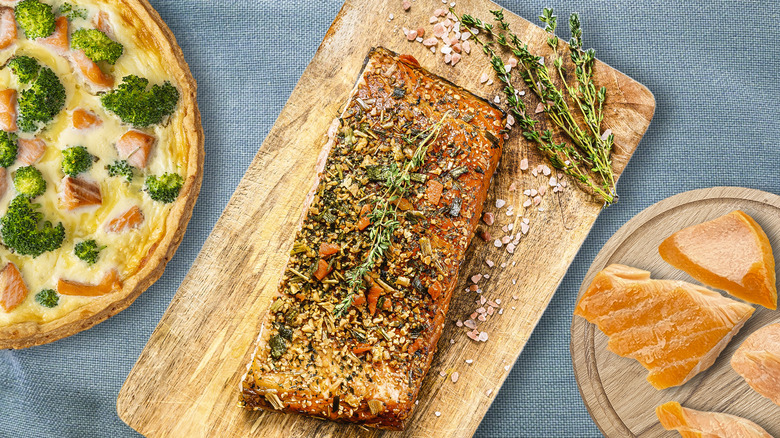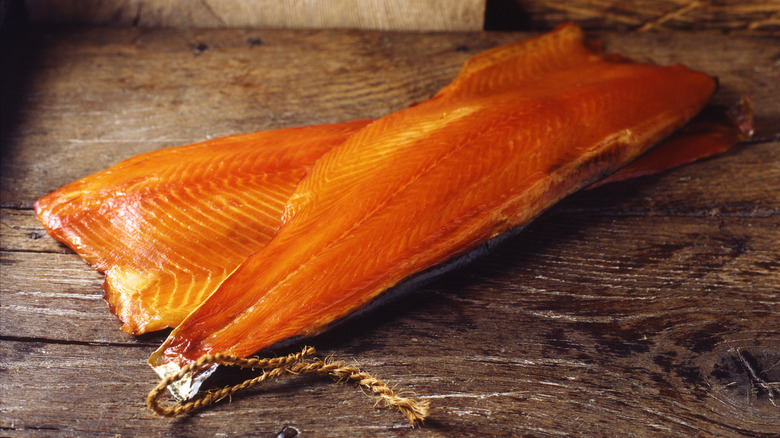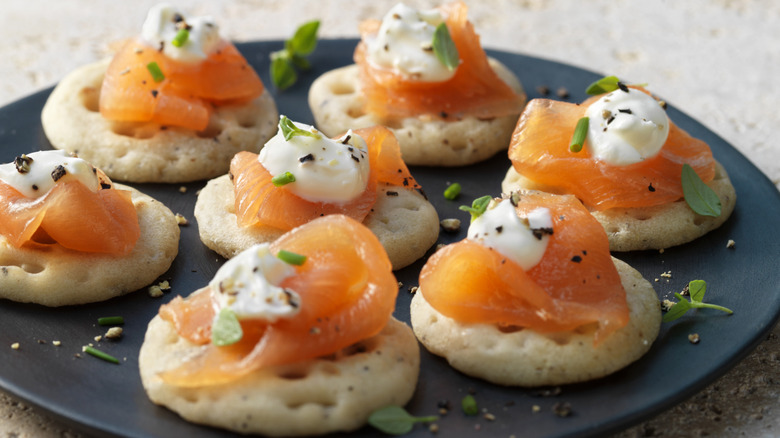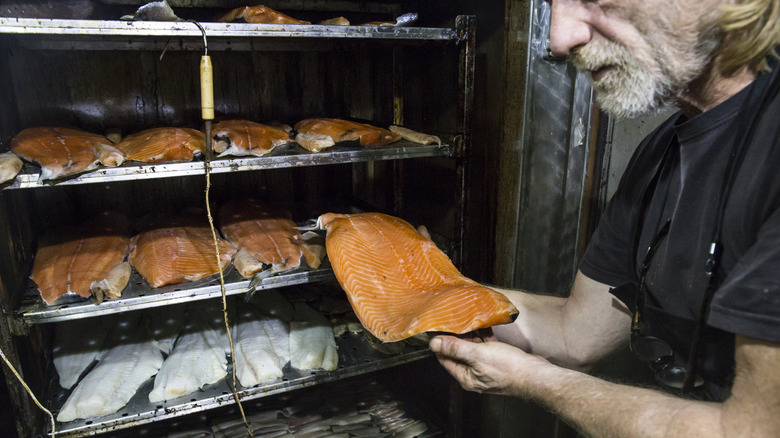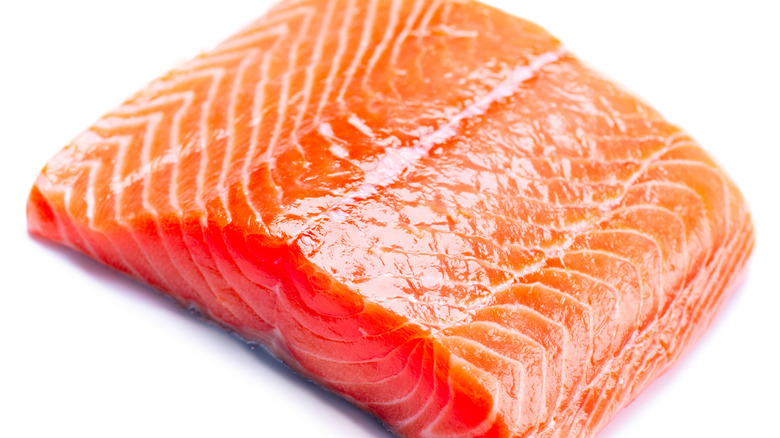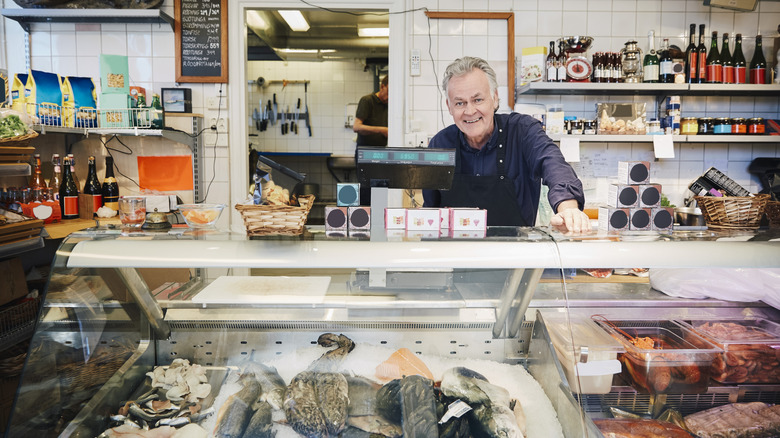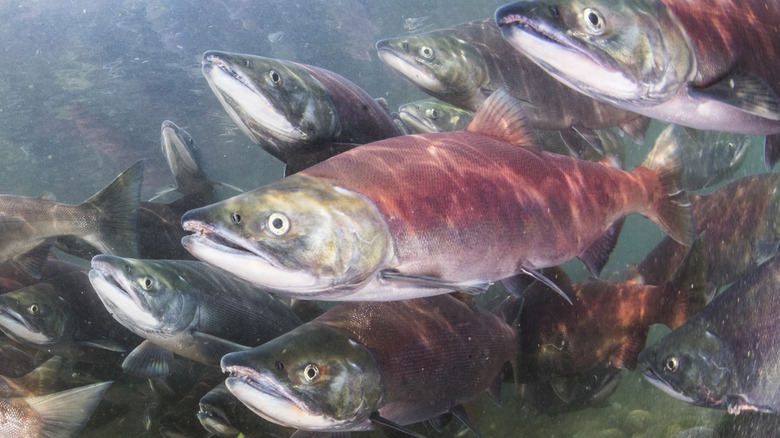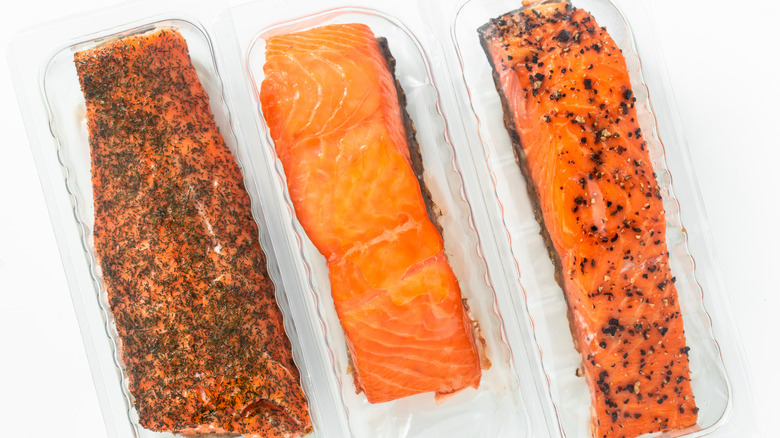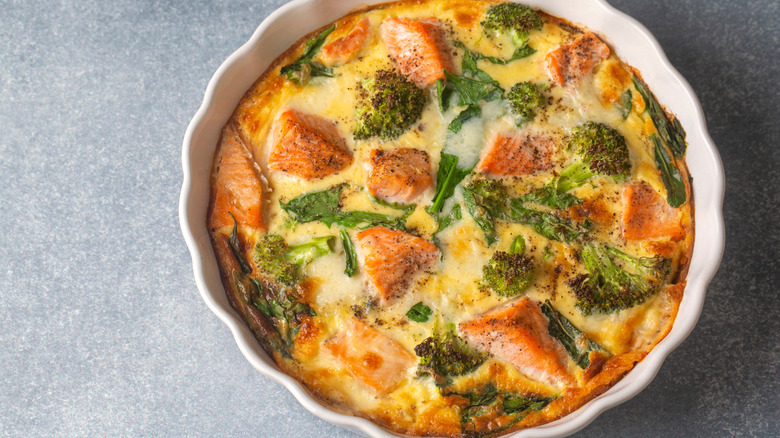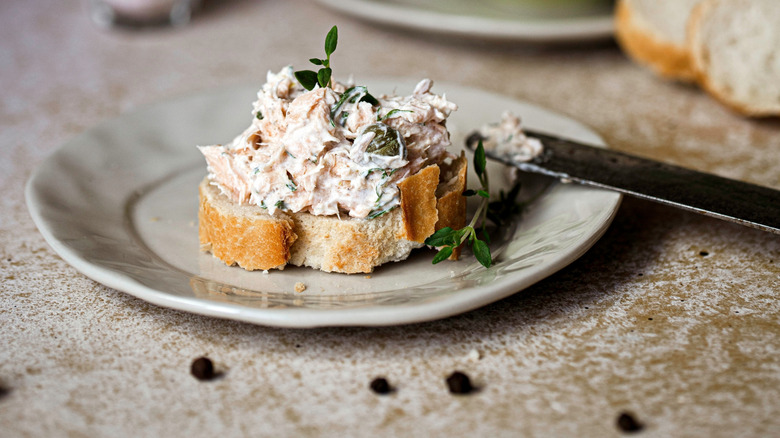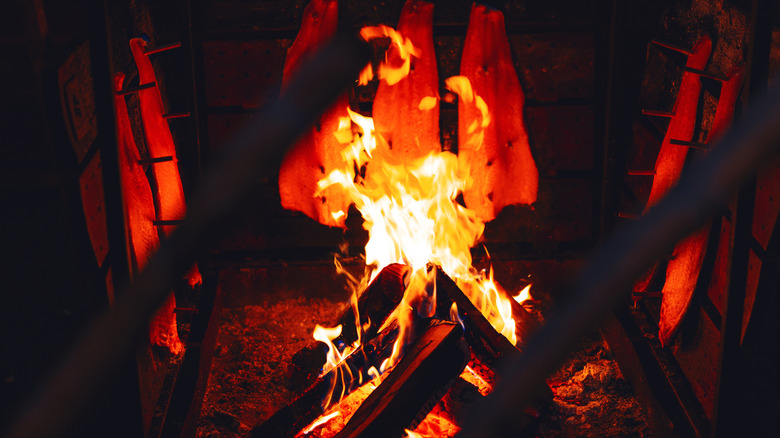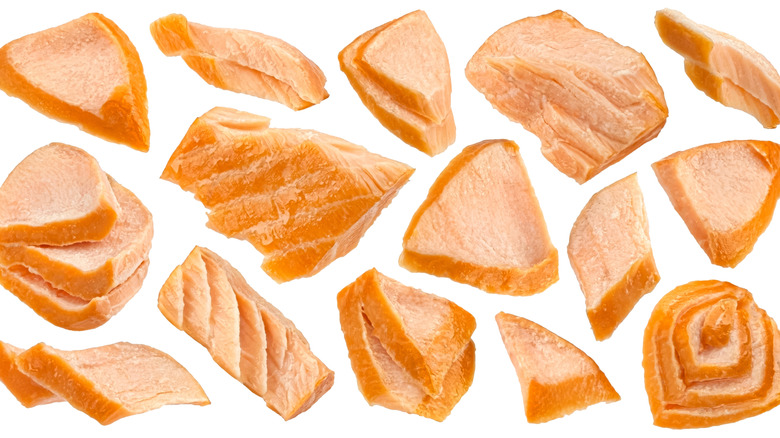Everything You Need To Know About Smoked Salmon
Rich, salty, and with plenty of that delicious umami flavor it's known for, smoked salmon is a delicious addition to pretty much any meal: breakfast, brunch, lunch, afternoon tea, and dinner.
It is expensive, though, so between its price and not knowing how to cook or eat it properly, many people avoid salmon entirely unless they happen to be at a restaurant where it's on offer. That's a shame, because smoked salmon is both delicious and healthy for you, and should have a place in every home kitchen.
Chowhound sat down with two professional chefs to get their take on everything salmon-related. They shared information on what it is, how it's made, the different types of smoked salmon to consider, how to find the best product for the most affordable price, and the yummiest ways to use it in meals. Get ready to be demystified.
What is smoked salmon?
First, let's start with salmon itself. This cold-water fish spends much of its life in the open ocean, where its scales are silvery in color. However, that color changes — depending on the species — as salmon return to their native breeding grounds where they were spawned and will spawn new salmon in their turn. The name "salmon" applies to fish in the Salmonidae family, including both Salmo (Atlantic) and Oncorhynchus (Pacific) genera.
Smoked salmon has a rich history across the world. It was smoked and relied on as a staple in communities ranging from First Nations in the Pacific Northwest and Alaska to parts of Medieval Europe and Scandinavia. A strong love of salmon still thrives in these areas. Today, you'll find salmon in diners, fancy French restaurants, and food carts alike ... not to mention the home kitchen.
Smoked salmon versus lox
Many folks refer to lox colloquially as smoked salmon, likely due to seeing lox listed this way in brick-and-mortar stores. You will also often find photos of lox heading internet articles about smoked salmon. While they have similarly rich tastes and cured natures, they're not the same. "The difference is in the process," says James Callery, head chef at Cross Keys in Newbury. "Smoked salmon is, you guessed it, smoked. Lox, on the other hand, is cured in salt but never sees a whiff of smoke. It has a softer, more buttery texture and a stronger, saltier taste." They are used differently in the kitchen as well. "Smoked salmon brings richness and a subtle smokey depth, while lox is fresher, brinier, and more 'zingy.'"
The driving force behind the invention of lox was also preservation in a time predating widespread refrigeration, says Anthony D'Angelo, co-owner of Samuels Seafood Company. "It's made by curing a salmon belly fillet in a salty brine, typically for three months. This process gives lox its signature salty flavor, making it saltier and brinier than both hot- and cold-smoked salmon."
Unlike smoked salmon, which is hard to fake without a smoker, you can make imitation lox pretty easily at home, according to James Callery. "It's as simple as salt, sugar, and a bit of time," he says. "Wrap it tight, leave it in the fridge for 24 to 48 hours, and you'll have your very own 'lox' ready to slice."
Hot- versus cold-smoked salmon
As the name suggests, smoked salmon is salmon that has been cured using woodsmoke in a process that takes several days. There are two basic approaches to smoking salmon: hot and cold. "Hot-smoked salmon is briefly cured (for a few hours) and cooked as it smokes, resulting in a texture similar to conventionally cooked salmon," explains Anthony D'Angelo. "It's typically firm and flakes easily." If you see flakes of cured salmon on top of a canape, for instance, that salmon has been hot-smoked.
Cold-smoked salmon doesn't flake. This is due to a different curing process. After brining, "cold-smoked salmon is cured for a longer period (at least a day) and then smoked for up to 12 hours, usually in a separate chamber from the heat source," D'Angelo says. The resulting fish is soft, silky, moist, and glistening. It has a more delicate flavor, similar to lox or crudo, and lends itself well to slicing. Cold-smoked salmon is why so many people get confused between smoked salmon and lox, but it is less salty and tastes smoky. You may also find yourself confused about the difference between lox and nova salmon, but the latter is simply another cold-smoked preparation.
So how exactly is it made?
Now to the nitty-gritty: How exactly is smoked salmon made? In a nutshell, it requires first brining and then curing the fish using heat, which helps to preserve it in multiple ways. While cold-smoking uses a longer process and a lower dose of heat than hot-smoking, the process is essentially the same.
Basic smoked salmon uses a good-sized salmon fillet with either the skin on or off, though skin-on imparts a nice flavor and acts as a moisture barrier. The salmon is first cured, which means coated in a mixture of sugar, salt, and spices. This draws moisture out of the fish and creates a nice coating of syrup on the outside. Common salt-to-sugar ratios are either 2:1 (for a more savory approach) or 1:2 (for a sweeter one). Once the curing is done (usually about 12 hours), the fish is then washed to remove the excess seasonings and then patted dry. The curing stage finishes with air-drying, ideally for several hours to several days in a refrigerated location, with equal airflow above and below.
Then to the eponymous step: smoking. Cold smoking takes place at temperatures less than 50 degrees Fahrenheit, while hot smoking is, shockingly, hotter. The type of wood used can impart different flavors to the fish, which is why you will sometimes see them noted on the packaging. This is something you can ask the purveyor about if you are interested.
Where to get good, affordable smoked salmon
You can buy smoked salmon online fairly easily, often for a better price than you'll find at your neighborhood grocery store. However, if you want the best possible product, it's better to source it professionally, according to James Callery. "If you can, go to a local fishmonger," he says. "Not only is it fresher, but you can usually ask questions about the source, how it was smoked, and when it was prepared." Some even offer slicing to order, Anthony D'Angelo says.
When picking out smoked salmon, look for bright flesh without being overly orange or red, which could indicate the salmon was dyed. "You're going for a deep, rich pink or orange," says D'Angelo. Texture matters too; your fish should be both firm and soft, but never mushy. Avoid anything gray or unappealing. "If it looks lifeless, it probably tastes lifeless," says Callery. "And the smell? It should be subtle, smoky, and fresh. If it smells like low tide, run away."
Callery also advises you to check the package and watch out for moisture. "Good smoked salmon shouldn't be swimming in its own juices," he says. During the holidays is a good time to search for a steal. According to Callery, "many independent producers sell top-quality stuff at decent prices this time of year." Markets and Christmas fairs are good prospects.
Smoked salmon sustainability concerns
As with any type of seafood (or any food, as it seems these days), there are sustainability concerns when it comes to smoked salmon. "The biggest issues with smoked salmon are overfishing, fish farming practices, and packaging waste," James Callery explains. This goes for both wild and farmed varieties. "Wild-caught salmon faces problems like overfishing and disrupting marine ecosystems, while poorly managed fish farms can cause pollution and disease spread."
On top of that, there's the packaging issue. While it's the best way to keep salmon fresh, it's not ideal for the planet, causing problems from overflowing dumps to the Great Pacific Garbage Patch, a swirling iceberg of debris in the middle of the ocean. Take heart, though; there are ways to consume smoked salmon sustainably.
Buy local if you can, Callery says. "Local means less of a carbon footprint and fresher fish." Labels such as "wild-caught" or "responsibly sourced" indicate better practices than those that don't have labels, as are certifications such as MSC (Marine Stewardship Council) or ASC (Aquaculture Stewardship Council). Seafood Watch also offers good advice on where to get salmon. Lastly, Callery advises that you should be selective about portions: "Smoked salmon is a luxury, so treat it like one. Buy what you need instead of overstocking, which reduces waste and makes you appreciate it more."
How to store it
Wondering how long smoked salmon is good for after opening? When you first make a purchase, check the label for a best-by date, which is when you should use up the fish. In general, smoked salmon should last two to three weeks in the fridge. If you're not going to use all the salmon in that time, you should freeze it by layering it between wax or parchment paper in an airtight container for up to four months. Make sure you get a good seal.
You also shouldn't leave foods in the "danger zone" between 40 and 140 degrees Fahrenheit for longer than two hours, according to the U.S. Department of Agriculture. In this temperature range, bacteria can multiply quickly, causing food to become unsafe. If the ambient temperature is 90 degrees Fahrenheit or above, make sure to limit exposure to an hour. Although smoked foods are more inhibitive to bacterial growth than fresh ones (hence the ancient use of this preservation technique), it's better to be safe than sorry.
Once you cook smoked salmon into a recipe, you should follow the USDA's guidelines about storing cooked food. In a nutshell, refrigerate it promptly and avoid that same danger zone, which is all the more pressing for hot food. You can safely keep leftovers in the fridge for three to four days, after which you're at greater risk of food poisoning. If you can't consume your leftovers within that time, throw them in the freezer, tightly wrapped, for three to four months.
Smoked salmon recipes FTW
What can you do with smoked salmon? A better question is what *can't* you do? First up, it's an obvious choice for the leading meal of the day. "Smoked salmon is a breakfast favorite, typically paired with bagels, cream cheese, onions, capers, tomatoes, avocado, or anything else you like," Anthony D'Angelo says. "Hot-smoked salmon also works well with scrambled eggs."
For lunch, both hot- and cold-smoked salmon work well in salads, creamy soups, or pasta dishes, D'Angelo says. Of course, "A squeeze of lemon enhances any preparation." Other lunch favorites include smoked salmon tartine, which James Callery describes as an open-faced sandwich with lemon crème fraîche, capers, and radish on sourdough. "It's light, fresh, and looks like you've put in way more effort than you have," he says. Smoked salmon wraps with cream cheese and cucumber are another of his favorites. "Another winner is smoked salmon potato cakes," Callery says. They're simple: just grate some potato and pan-fry it with a little crème fraîche, smoked salmon, and dill.
When it comes to dinner, pasta is top of mind. "Think creamy lemon garlic pasta with flakes of smoked salmon stirred through," Callery says. His personal favorite, however, is smoked salmon-stuffed mushrooms. All you do is scoop out portabellos, toss in some garlic cream cheese and smoked salmon, and bake until the whole thing is bubbly and golden. It's not that fancy, but just like the tartine, it sure feels like it.
Party food, smoked salmon-style
Smoked salmon's delicacy and luxury mean it lends itself well to classy party food and downhome bites alike. Both hot- and cold-smoked salmon are salty and strongly flavored, so a little goes a long way, making them perfect for small bites such as canapes, baby quiches, or finger sandwiches.
For the pescatarians of the world, or for those who simply want a different take on an old classic, consider smoked salmon tartar. Smoked salmon dip is another popular party food, perfect for eating with crostini or fresh, chewy bread. And who doesn't love a tiny pancake topped with sour cream, horseradish, smoked salmon, caviar, and dill? (No one doesn't. That's who.)
For a more informal brunch or party dining situation, you might consider making a smoked salmon platter. Put thinly sliced cold-smoked salmon on a big platter along with a cheese such as feta or labneh, and pile cucumbers, tomatoes, pickles, olives, artichoke hearts, onions, radishes, lemons, and herbs all around. Serve the platter with bagels or by itself for people to pick at as they talk and rub elbows. If you can't find cold-smoked salmon, lox will do just fine for this purpose.
Making it yourself
Yes, you can smoke salmon at home. "For the best results, purchase high-quality salmon from a reputable fishmonger, like Giuseppe's Market, since it's technically not cooked," Anthony D'Angelo says. You can get a smoker for home use for a pretty affordable price. If you get one intended for outdoor use, make sure you have an outdoor space in which to use it. If you only have indoor space, consider indoor smokers instead.
If you don't want to shell out for new equipment, you can use a home barbecue, according to James Callery. "Use a pan of wood chips to create that classic smoky flavor." If you're up for a challenge, he adds, "Cold-smoking is possible too, but it requires keeping the temperature very low, which isn't always easy without a proper kit." Make sure you have good safety gear, such as heat-resistant gloves, grilling goggles, and a good set of grilling tools.
Lastly, some people find it helpful to have a vacuum sealer on hand if you plan to make large quantities of smoked salmon at one time. This device is most often used by anglers, but enthusiastic home cooks are entitled to it as well. When making homemade smoked salmon, it's important to note that you don't just throw the fish in the smoker. Typically, you cure it with a mix of salt and sugar or brown sugar first. When you're just starting out, you can use home staples, but you might eventually move on to experimenting with fun flavors of sea salt or other upscale ingredients.
Nutritional information and health benefits
Most people know that salmon is "brain food." More specifically, it contains tons of omega-3 fatty acids. While all fish contain some omega-3s, salmon has an especially high concentration of them, because they store lots of oils in their muscles (i.e. the flesh that we eat). These compounds provide several important services in the body, including supporting cell function, especially those in your eyes and brain. (See? Brain food!) It also offers nutrients such as sodium, phosphorous, copper, selenium, riboflavin, niacin, and others.
As for health drawbacks, there are few. Although you might think you eliminate some calories as a result of smoking off the water, fresh and smoked salmon have somewhat similar calorie amounts. It's impossible to get a straight answer on which is higher in calories since sources vary, but it's not something you need to worry about.
In terms of health, the biggest concern vis-à-vis smoked salmon relates to the smoking process itself. Smoked foods do contain some carcinogens, either as a result of the smoke itself or due to interactions between the food and heat. To ameliorate the possible risks, use smoked foods as a treat rather than a staple. Which, given salmon's strong flavor and saltiness (as well as its price), shouldn't be too hard to do. Lastly, you should watch out for smoked salmon recalls, as they do happen.
